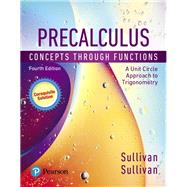NOTE: Before purchasing, check with your instructor to ensure you select the correct ISBN. Several versions of the MyLab™ and Mastering™ platforms exist for each title, and registrations are not transferable. To register for and use MyLab or Mastering, you may also need a Course ID, which your instructor will provide.
Used books, rentals, and purchases made outside of Pearson
If purchasing or renting from companies other than Pearson, the access codes for the MyLab platform may not be included, may be incorrect, or may be previously redeemed. Check with the seller before completing your purchase.
For corequisite courses in Precalculus.
This is a standalone access card for MyLab Math.
Full support for corequisite courses, with the hallmark Sullivan approach
The Sullivans are known for connecting with today’s students and encouraging a focus on the fundamentals. Based on Michael Sullivan III’s own experience teaching corequisite courses, they’ve designed a guided MyLab™ learning path – providing a comprehensive suite of resources that helps students to work smarter, and gives instructors the support and proven materials they need.
Precalculus: Concepts through Functions, A Unit Circle Approach to Trigonometry, A Corequisite Solution encompasses full text content for Precalculus and the Corequisite Support course, classroom activities, study skills, and thoughtfully prebuilt, pre-assigned assignments to help students progress through the essential material. Instructors are given complete flexibility in implementation, no matter how their corequisite course is set up.
Personalize learning with MyLab Math
By combining trusted author content with digital tools and a flexible platform, MyLab Math personalizes the learning experience and improves results for each student.
0135874653 / 9780135874653 MYLAB MATH WITH PEARSON ETEXT -- STANDALONE ACCESS CARD -- FOR PRECALCULUS: CONCEPTS THROUGH FUNCTIONS, A UNIT CIRCLE APPROACH TO TRIGONOMETRY, A COREQUISITE SOLUTION, 4/e











